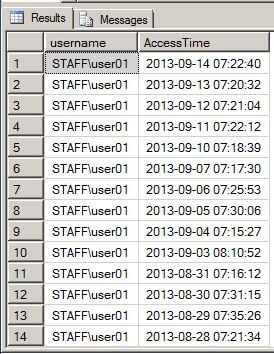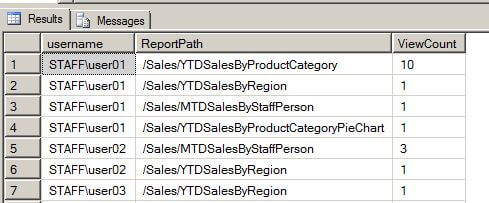In previous versions, SQL Server 2012 Reporting Services provides us with a number of tables and views to let us see who has accessed what report and when they accessed the report.
The T-SQL query below selects from the ExecutionLog2 view in the ReportServer database.
The first 13 rows output from the T-SQL code are shown below. As you
can see in this image, we can see who viewed which report, when they
viewed the report, and which parameters if any were passed to the
report. This query itself could be used within an SSRS report and then
published to the report server.
 Using a query similar to the one shown below, we can look at the
TimeEnd column to determine when the reports are being viewed. This will
help us gain insight into when our processes that are generating the
data behind the reports should complete. We can also look at the results
of this query to determine behavioral patterns of the report users.
Using a query similar to the one shown below, we can look at the
TimeEnd column to determine when the reports are being viewed. This will
help us gain insight into when our processes that are generating the
data behind the reports should complete. We can also look at the results
of this query to determine behavioral patterns of the report users.
 The query shown below will return the report access counts per user and report for the current month.
The query shown below will return the report access counts per user and report for the current month.

The T-SQL query below selects from the ExecutionLog2 view in the ReportServer database.
USE ReportServer; GO SELECT el2.username,el2.InstanceName, el2.ReportPath,el2.TimeStart, el2.TimeEnd,el2.[Status], isnull(el2.Parameters, 'N/A') as Parameters FROM ExecutionLog2 el2 GO

USE ReportServer; GO SELECT username, convert(varchar(25),TimeEnd, 120) as AccessTime FROM ExecutionLog2 WHERE status='rsSuccess' AND username='STAFF\user01' AND ReportPath='/Sales/YTDSalesByProductCategory' ORDER BY AccessTime desc GO

USE ReportServer; GO SELECT username, ReportPath, count(*) as ViewCount FROM ExecutionLog2 WHERE status='rsSuccess' AND TimeEnd>=DATEADD(mm, DATEDIFF(mm, 0, GETDATE()), 0) GROUP BY username, ReportPath ORDER BY username, ViewCount desc GO

No comments:
Post a Comment